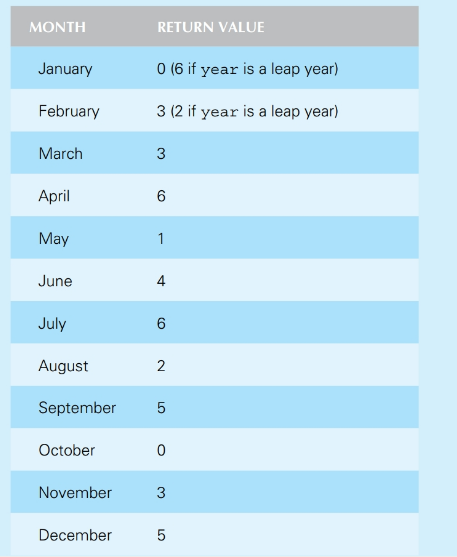
Write a
will require several functions:
bool isLeapYear (int year) ;
This function should return true if year is a leap year and false if it is not. Here is pseudocode to determine a leap year:
leap_year = ((year divisible by 400) or (year divisible by 4 and year not divisible by 100))
int getCenturyValue (int year) ;
This function should take the first two digits of the year (i.e., the century), divide by 4, and save the remainder. Subtract the remainder from 3 and return this value multiplied by 2. For example, the year 2008 becomes
int getYearValue (int year) ;
This function computes a value based on the years since the beginning of the century. First, extract the last two digits of the year. For example, 08 is extracted for 2008. Next, factor in leap years. Divide the value from the previous step by 4 and discard the remainder. Add the two results together and return this value. For example, from 2008 we extract 08. Then
int getMonthValue (int month, int year) ;
This function should return a value based on the following table and will require invoking the isLeapYear function:

Finally, to compute the day of the week, compute the sum of the date’s day plus the values returned by getMonthVaIue, getYearVaIue, and getCenturyVaIue. Divide the sum by 7 and compute the remainder. A remainder of 0 corresponds to Sunday, 1 corresponds to Monday, etc.—up to 6—which corresponds to Saturday. For example, the date July 4, 2008 should be computed as
Your program should allow the user to enter any date and output the corresponding day of the week in English.
Want to see the full answer?
Check out a sample textbook solution
Chapter 3 Solutions
Absolute C++
Additional Engineering Textbook Solutions
Computer Science: An Overview (13th Edition) (What's New in Computer Science)
Database Concepts (8th Edition)
Concepts Of Programming Languages
Starting Out with Java: From Control Structures through Objects (7th Edition) (What's New in Computer Science)
Electric Circuits. (11th Edition)
Java: An Introduction to Problem Solving and Programming (8th Edition)
- 2:21 m Ο 21% AlmaNet WE ARE HIRING Experienced Freshers Salesforce Platform Developer APPLY NOW SEND YOUR CV: Email: hr.almanet@gmail.com Contact: +91 6264643660 Visit: www.almanet.in Locations: India, USA, UK, Vietnam (Remote & Hybrid Options Available)arrow_forwardProvide a detailed explanation of the architecture on the diagramarrow_forwardhello please explain the architecture in the diagram below. thanks youarrow_forward
- Complete the JavaScript function addPixels () to calculate the sum of pixelAmount and the given element's cssProperty value, and return the new "px" value. Ex: If helloElem's width is 150px, then calling addPixels (hello Elem, "width", 50) should return 150px + 50px = "200px". SHOW EXPECTED HTML JavaScript 1 function addPixels (element, cssProperty, pixelAmount) { 2 3 /* Your solution goes here *1 4 } 5 6 const helloElem = document.querySelector("# helloMessage"); 7 const newVal = addPixels (helloElem, "width", 50); 8 helloElem.style.setProperty("width", newVal); [arrow_forwardSolve in MATLABarrow_forwardHello please look at the attached picture. I need an detailed explanation of the architecturearrow_forward
- Information Security Risk and Vulnerability Assessment 1- Which TCP/IP protocol is used to convert the IP address to the Mac address? Explain 2-What popular switch feature allows you to create communication boundaries between systems connected to the switch3- what types of vulnerability directly related to the programmer of the software?4- Who ensures the entity implements appropriate security controls to protect an asset? Please do not use AI and add refrencearrow_forwardFind the voltage V0 across the 4K resistor using the mesh method or nodal analysis. Note: I have already simulated it and the value it should give is -1.714Varrow_forwardResolver por superposicionarrow_forward
- Describe three (3) Multiplexing techniques common for fiber optic linksarrow_forwardCould you help me to know features of the following concepts: - commercial CA - memory integrity - WMI filterarrow_forwardBriefly describe the issues involved in using ATM technology in Local Area Networksarrow_forward
 C++ Programming: From Problem Analysis to Program...Computer ScienceISBN:9781337102087Author:D. S. MalikPublisher:Cengage Learning
C++ Programming: From Problem Analysis to Program...Computer ScienceISBN:9781337102087Author:D. S. MalikPublisher:Cengage Learning C++ for Engineers and ScientistsComputer ScienceISBN:9781133187844Author:Bronson, Gary J.Publisher:Course Technology PtrCOMPREHENSIVE MICROSOFT OFFICE 365 EXCEComputer ScienceISBN:9780357392676Author:FREUND, StevenPublisher:CENGAGE L
C++ for Engineers and ScientistsComputer ScienceISBN:9781133187844Author:Bronson, Gary J.Publisher:Course Technology PtrCOMPREHENSIVE MICROSOFT OFFICE 365 EXCEComputer ScienceISBN:9780357392676Author:FREUND, StevenPublisher:CENGAGE L EBK JAVA PROGRAMMINGComputer ScienceISBN:9781337671385Author:FARRELLPublisher:CENGAGE LEARNING - CONSIGNMENT
EBK JAVA PROGRAMMINGComputer ScienceISBN:9781337671385Author:FARRELLPublisher:CENGAGE LEARNING - CONSIGNMENT Microsoft Visual C#Computer ScienceISBN:9781337102100Author:Joyce, Farrell.Publisher:Cengage Learning,
Microsoft Visual C#Computer ScienceISBN:9781337102100Author:Joyce, Farrell.Publisher:Cengage Learning,




